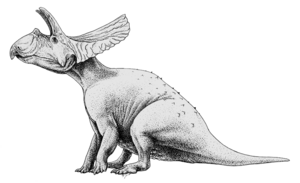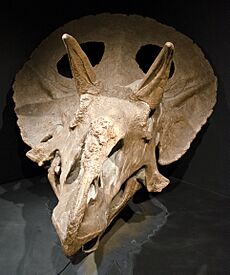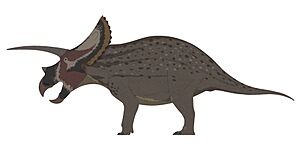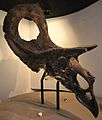Torosaurus facts for kids
Quick facts for kids TorosaurusTemporal range: Upper Cretaceous
|
|
|---|---|
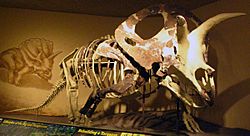 |
|
| Mounted Torosaurus in Milwaukee | |
| Scientific classification | |
| Kingdom: | |
| Class: | |
| Superorder: | |
| Order: | |
| Suborder: | |
| Infraorder: | |
| Family: | |
| Subfamily: |
Ceratopsinae
|
| Genus: |
Torosaurus
Marsh, 1891
|
Torosaurus means "pierced lizard." It was a huge, plant-eating dinosaur with four legs. This dinosaur had three horns on its large head. Torosaurus hatched from eggs. It might have lived in groups, like herds.
This dinosaur lived about 70 to 65 million years ago. This was during the Upper Cretaceous period. It lived in what is now western North America. Torosaurus looked a lot like Triceratops. Some scientists once thought Triceratops was just a younger Torosaurus.
Torosaurus had the biggest skulls of any known land animal. Its frilled skull could be over 9 feet (2.77 meters) long! It was probably the same size as Triceratops. But Torosaurus had a longer frill with big oval holes. It also had long bones on its frill with a groove. Plus, it had five or more pairs of small horns on the back of its frill. Torosaurus did not have a long nose horn like some Triceratops. Instead, it had a short nose horn, similar to an older type of Triceratops.
Contents
How Was Torosaurus Discovered?
In 1891, two years after Triceratops was named, two special skulls were found. These skulls belonged to horned dinosaurs. They had long frills with holes in them. John Bell Hatcher found them in Wyoming. His boss, Professor Othniel Charles Marsh, gave them the name Torosaurus.
The name Torosaurus is often thought to mean "bull lizard." This comes from the Latin word taurus or the Spanish word toro. But it most likely comes from a Greek word. That word is toreo, which means "to perforate" or "to pierce." This name refers to the "window-like" holes in its long frill. These holes helped tell it apart from Triceratops, which had a solid frill. Marsh never fully explained why he chose the name.
What Torosaurus Species Are There?
Two types of Torosaurus have been found:
- T. latus (named by Marsh in 1891). Latus means "the wide one" in Latin. This refers to its wide frill.
- T. utahensis (named by Gilmore in 1946).
Another species, T. gladius, was once thought to be different. But now, it is considered the same as T. latus. Gladius means "sword" in Latin. This was because of the sword-like shape of its frill bones.
Most Torosaurus fossils are rare. Triceratops fossils are much more common. Fossils of Torosaurus have been found in places like Wyoming, Montana, and South Dakota. They have also been found in Utah and Saskatchewan, Canada.
Torosaurus utahensis was first called Arrhinoceratops utahensis in 1946. Later, in 1976, it was renamed Torosaurus utahensis. Some research suggests T. utahensis might be older than T. latus. Scientists are still studying if T. utahensis should be its own genus. They also wonder if T. latus is just a grown-up Triceratops.
What Did Torosaurus Look Like?
Torosaurus was a very large dinosaur. It was similar in size to the biggest Triceratops. It could be 24 to 30 feet (7.5 to 9 meters) long. It weighed about 4 to 6 tons (8,000 to 12,000 pounds). Its skull was especially long because of its huge frill.
Early estimates said its skull was about 7.7 feet (2.35 meters) long. This made Torosaurus seem to have the longest skull of any land animal. But later, even longer skulls were found. One skull, nicknamed "Adam," is the largest known. It measures 9.8 feet (3 meters) long!
In 2006, scientists found some key features of Torosaurus:
- Its frill was very long compared to the rest of its skull.
- The back edge of the frill had ten or more small, triangular bones.
- It did not have a triangular bone in the middle of its frill.
- The main bone of the frill was thin. It had round or oval holes.
- This frill bone was about 20% wider than it was long.
One special feature of T. latus was a clear ridge on its frill bone. It also had a deep groove next to it.
Scientists have noticed that Torosaurus fossils are a bit different from each other. The horns above the eyes could be large and curved forward. Or they could be short and straight. Their position also varied. The nose horn also differed. Some had a straight, upright horn. Others had only a small bump. The frill itself could curve upwards or be nearly flat. Some frills were heart-shaped.

Despite these differences, scientists say the variety is normal for related dinosaurs. They also found that, apart from the frill, Torosaurus and Triceratops were very similar.
How Is Torosaurus Classified?
In 1891, Marsh placed Torosaurus in the Ceratopsidae family. This family is part of Ceratopsia. Ceratopsia means "horned faces." This group of plant-eating dinosaurs had beaks like parrots. They lived in North America and Asia during the Jurassic and Cretaceous periods.
Torosaurus has always been grouped with dinosaurs that have long frills. This group is called Chasmosaurinae. It was thought to be a late relative of dinosaurs like Anchiceratops. Triceratops was once thought to be in a different group because of its short frill. But later studies showed that both Torosaurus and Triceratops belong to the Chasmosaurinae group. Now, scientists always find that Torosaurus and Triceratops are very closely related.
Here is a family tree (cladogram) showing where Torosaurus fits in:
| Ceratopsidae |
|
|||||||||||||||||||||||||||||||||||||||||||||||||||||||||||||||||||||||||||||||||||||||
Images for kids
See also
 In Spanish: Torosaurus para niños
In Spanish: Torosaurus para niños



